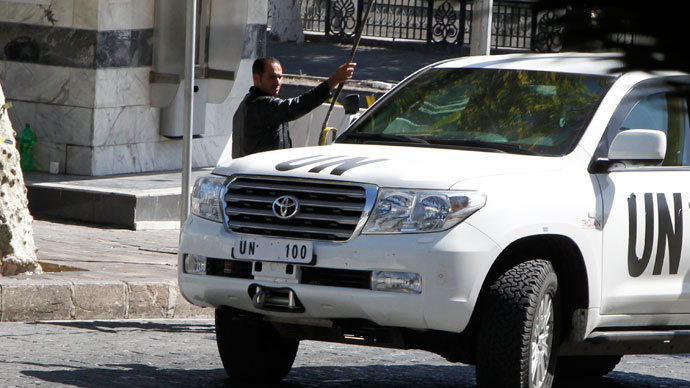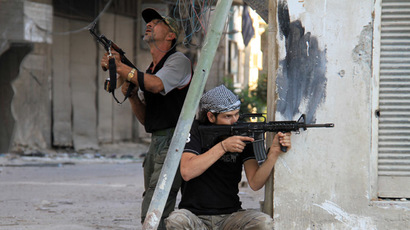UN: Chem arms used in Syria, links between attacks, victims, locations unclear

The United Nations has released its report on the alleged use of chemicals weapons in Syria, as investigators report evidence of probable chemical weapons use in five of seven attacks probed.
"The United Nations Mission concludes that chemical weapons have been used in the ongoing conflict between the parties in the Syrian Arab Republic," said chief UN investigator Ake Sellstrom in a report released Thursday.
The purpose of the report was to determine whether chemical weapons were used, not who used them. Both the Syrian government and the opposition have accused each other of using chemical weapons. Both have denied all allegations.
The report said that in several instances, victims included soldiers and civilians. However, it was not always possible to determine direct links between the attacks, victims, and alleged sites of the incidents.
“The United Nations Mission collected clear and convincing evidence that chemical weapons were used also against civilians, including children, on a relatively large scale in the Ghouta area of Damascus on 21 August 2013,” the report concludes.
The UN team says this overall assessment is based on findings of “impacted and exploded surface-to-surface rockets...found to contain Sarin”; in areas around where patients were affected, the environment was found to be “contaminated by Sarin”; over 50 interviews with survivors and health workers provided “corroboration of the medical and scientific results”; many patients and survivors were “diagnosed as intoxicated by an organophosphorous compound”; and blood and urine samples taken from the same patients tested “positive for Sarin and Sarin signatures.”
Based on the “sufficiency and credibility of the information received,” the UN team investigated seven of 16 sites connected to allegations reported to the UN Secretary-General by member states.

The investigated sites and dates reported by the UN team are: Khan Al Asal on March 19, 2013; Sheik Maqsood on April 13, 2013; Saraqueb on April 29, 2013; Ghouta on August 21, 2013; Bahhariyeh on August 22, 2013; Jobar on August 24, 2013; Ashrafiah Sahnaya on August 25, 2013.
Five cases of chemical arms usage
In addition to “clear and convincing” evidence of sarin use in Ghouta, as Sellstrom reported in September, the UN mission found likely use of chemical weapons in all other investigated sites, with the exception of Sheik Maqsood and Bahhariyeh.
The use of sarin is also suspected at Saraqueb, near Idlib, and Jobar and Ashrafiat Sahnaya, both near Damascus.
The incident at Khan Al Asal was reported by the Syrian government, which stated that 20 people died and 124 survivors were poisoned. One survivor stated that “the air was static and filled with a yellowish-green mist and filled of a strong pungent smell, possibly resembling sulfur.”
Saraqueb was reported by France and the United Kingdom, which stated that a small amount of toxic substance was used. One severely intoxicated patient died. Several less intoxicated survived.
Sheik Maqsood, where evidence of weapon-use was inconclusive, was reported by the US, which claimed Syria’s culpability.
In Bahhariyeh, “blood and urine samples were collected from the most severely intoxicated patients. The analysis results tested negative for any of the chemical warfare agents.”
Four Syrian soldiers were “severely affected” in Jobar, but all survived. The UN team “found the site to have been corrupted by mine-clearing activities” by the government, though it could not ultimately verify Syria’s claim that sarin was used.
In Ashrafiat Sahnaya, the incident occurred where government soldiers patrolled a checkpoint controlling entry to rebel-held areas. All five blood samples given to the UN team by the Syrian government tested positive for sarin exposure.
Sellstrom’s investigation was established by UN Secretary-General Ban Ki-moon after the Syrian government claimed rebels used chemical weapons in Khan Al Asal.
The Syrian government agreed to destroy its chemical stockpile after the Ghouta attack, near Aleppo. President Bashar Assad’s regime also acceded to the Chemical Weapons Convention.
Western powers led by the United States said the August 21 attack that killed hundreds pointed to Assad’s forces, while Syria and Russia pinned it on rebel factions.
The UN Security Council adopted a resolution - brokered by Russia and the US - in September to enforce Syria’s eradication of weapons, which requires Assad’s government to fully destroy its arsenal by mid-2014.
The Organization for the Prohibition of Chemical Weapons is responsible for overseeing the elimination of the weapons cache.














